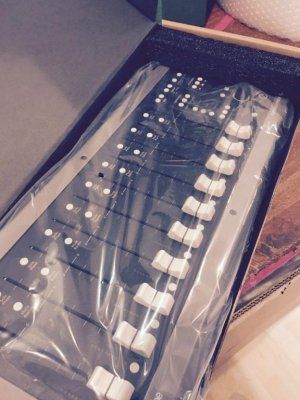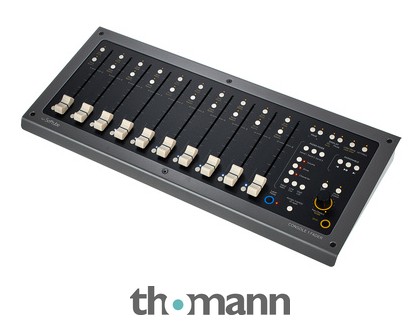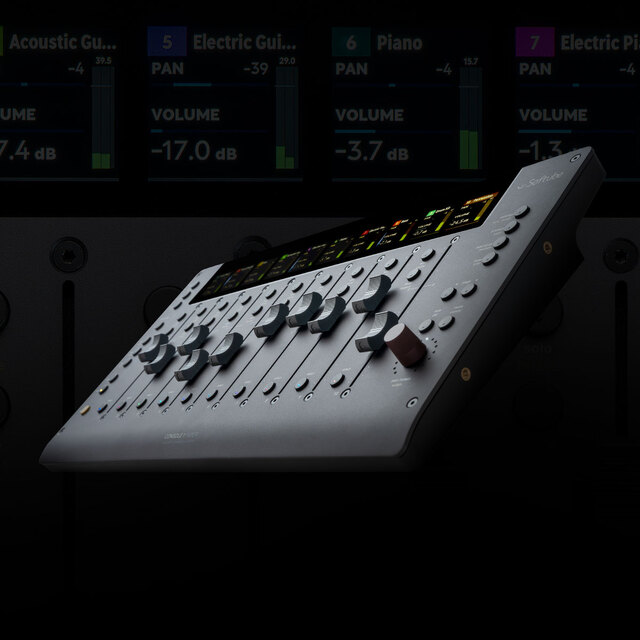monophonK
||||||||||
Softube wird am 15.10.19 wahrscheinlich eine „Console 1 Fader“ vorstellen.
Folgende Angaben habe ich diesbezüglich gefunden:
„Transport controls: The assignable buttons work as a regular keyboard where you can assign a keycommand (like CTRL-Z) to the button. It’s predefined to work as basic transport control for the major DAWs but can be used any way imaginable.
Fader modes: The faders are not only output volume, but can be used to control the character of the track with Drive, Drive Character, High Cut, Low Cut, Input Gain and Sends. With the different fader modes you will be able to quickly balance, clean-up and glue together a mix.
Page Up/Down: More than 10 tracks or layers? Use Page Up/Down to toggle through the different pages.
Layer Mode: Allows you to create layers of tracks (permanent groups), rearrange tracks, or organize your tracks with another layout than the track order in your DAW. It’s easy to create a page with a drum group, guitar group and individual vocal tracks for easy access to the most important elements of the mix.
Console 1 Fader is a set of ten motorized faders for your digital audio workstation (DAW). Console 1 Fader lets your fingers do the delicate job of mixing the levels of your audio tracks. Plus pan, mute and solo, high/low cut, drive, aux sends, and more. In short, you get the benefits of working with a physical mixer, without the price and size. Console 1 Fader also integrates seamlessly with Softube Console 1, so if you already have the first unit you’ll get a complete channel strip solution (with Console 1’s Shape, Equalizer and Compressor sections).
The faders are the main tools on Console 1 Fader. You can use them exactly as any other mixer, and their graphical positions represent the actual volume settings of the tracks.
They are also motorized, so when you use automation to add relative dynamic changes to your mix, the faders move accordingly.
At the top of each Console 1 Fader channel is the Solo/Phase button. The Solo function is convenient, when you want to hear one or several tracks in isolation. By holding Console 1 Fader’s Shift button, you can turn the Phase of a channel by 180 degrees. This can be useful in a few particular cases, e.g. when mixing a drumkit with phase issues.
As with most digital mixing devices, there are a lot more channels available than meet the eye. By pressing the Page + and Page – buttons, you can scroll through your mixing channels ten channels at a time. So when looking at channels 1–10, pressing + will take you to channels 11–20, and so on. Pressing – takes you back again.
The encoder to the right is used to control functions as Pan and Width (with stereo channels). After Console 1 Fader has been instantiated on a track, press Display On to see the big On-Screen Display (OSD). This is where the action is! Press Display On again to make the OSD disappear.
Hold down Shift (on Console 1 Fader, not your computer keyboard) and press the Display On/Auto button. You have now activated Auto mode. This is a convenient function that makes the OSD pop up whenever you touch any the Console 1 Fader controls. After a few seconds of inactivity, the OSD disappears.
You can turn Auto mode off by pressing Shift + Display On/Auto again. When several mixer channels can be considered as “one component” or “one complete section” in you mix, it is often convenient to group them. On a physical mixing desk, there are usually group outputs. They let you assign a bunch of channels of, say, backing vocals to a group and adjust the total volume of that group with one slider (or a stereo pair of them). That way, while adjusting the overall volume of the backing vocals, you retain the internal volume relationship between those channels.
TECHNICAL SPECIFICATIONS
Dimensions (approx.) 43 cm x 4 cm x 19 cm (WxHxD)
Weight (approx.) 2,2 kg / 3 kg
Faders: 10 ALPS 100 mm high quality motorized faders with touch
Power: Powered by 8V DC. 3A. PSU included. 100-240V 0.75A
Computer connection: USB 2 Type-B
Chassis: Powder coated steel
Panel: Screen printed poly carbonate overlay (3 colors)
Meters: 10-segment LED meters (5 green, 2 yellow, 1 red/clip)
Encoder: 1, mounted on a high grade metal potentiometer“
Quelle:
 www.houseofsound.ch
www.houseofsound.ch
Folgende Angaben habe ich diesbezüglich gefunden:
„Transport controls: The assignable buttons work as a regular keyboard where you can assign a keycommand (like CTRL-Z) to the button. It’s predefined to work as basic transport control for the major DAWs but can be used any way imaginable.
Fader modes: The faders are not only output volume, but can be used to control the character of the track with Drive, Drive Character, High Cut, Low Cut, Input Gain and Sends. With the different fader modes you will be able to quickly balance, clean-up and glue together a mix.
Page Up/Down: More than 10 tracks or layers? Use Page Up/Down to toggle through the different pages.
Layer Mode: Allows you to create layers of tracks (permanent groups), rearrange tracks, or organize your tracks with another layout than the track order in your DAW. It’s easy to create a page with a drum group, guitar group and individual vocal tracks for easy access to the most important elements of the mix.
Console 1 Fader is a set of ten motorized faders for your digital audio workstation (DAW). Console 1 Fader lets your fingers do the delicate job of mixing the levels of your audio tracks. Plus pan, mute and solo, high/low cut, drive, aux sends, and more. In short, you get the benefits of working with a physical mixer, without the price and size. Console 1 Fader also integrates seamlessly with Softube Console 1, so if you already have the first unit you’ll get a complete channel strip solution (with Console 1’s Shape, Equalizer and Compressor sections).
The faders are the main tools on Console 1 Fader. You can use them exactly as any other mixer, and their graphical positions represent the actual volume settings of the tracks.
They are also motorized, so when you use automation to add relative dynamic changes to your mix, the faders move accordingly.
At the top of each Console 1 Fader channel is the Solo/Phase button. The Solo function is convenient, when you want to hear one or several tracks in isolation. By holding Console 1 Fader’s Shift button, you can turn the Phase of a channel by 180 degrees. This can be useful in a few particular cases, e.g. when mixing a drumkit with phase issues.
As with most digital mixing devices, there are a lot more channels available than meet the eye. By pressing the Page + and Page – buttons, you can scroll through your mixing channels ten channels at a time. So when looking at channels 1–10, pressing + will take you to channels 11–20, and so on. Pressing – takes you back again.
The encoder to the right is used to control functions as Pan and Width (with stereo channels). After Console 1 Fader has been instantiated on a track, press Display On to see the big On-Screen Display (OSD). This is where the action is! Press Display On again to make the OSD disappear.
Hold down Shift (on Console 1 Fader, not your computer keyboard) and press the Display On/Auto button. You have now activated Auto mode. This is a convenient function that makes the OSD pop up whenever you touch any the Console 1 Fader controls. After a few seconds of inactivity, the OSD disappears.
You can turn Auto mode off by pressing Shift + Display On/Auto again. When several mixer channels can be considered as “one component” or “one complete section” in you mix, it is often convenient to group them. On a physical mixing desk, there are usually group outputs. They let you assign a bunch of channels of, say, backing vocals to a group and adjust the total volume of that group with one slider (or a stereo pair of them). That way, while adjusting the overall volume of the backing vocals, you retain the internal volume relationship between those channels.
TECHNICAL SPECIFICATIONS
Dimensions (approx.) 43 cm x 4 cm x 19 cm (WxHxD)
Weight (approx.) 2,2 kg / 3 kg
Faders: 10 ALPS 100 mm high quality motorized faders with touch
Power: Powered by 8V DC. 3A. PSU included. 100-240V 0.75A
Computer connection: USB 2 Type-B
Chassis: Powder coated steel
Panel: Screen printed poly carbonate overlay (3 colors)
Meters: 10-segment LED meters (5 green, 2 yellow, 1 red/clip)
Encoder: 1, mounted on a high grade metal potentiometer“
Quelle:
Softube Console 1 Fader
Neu: jetzt mit vollem Support für Logic Pro - die Console 1 Controller lassen sich jetzt direkt in Logic Pro einbinden! Hybrider Hardware-Controller mit Software-Integration, bietet Zugriff auf zehn berührungssensitive Motorfader mit 12 cm Faderweg, Buttons für die Spurauswahl sowie Mute und...
Zuletzt bearbeitet:



